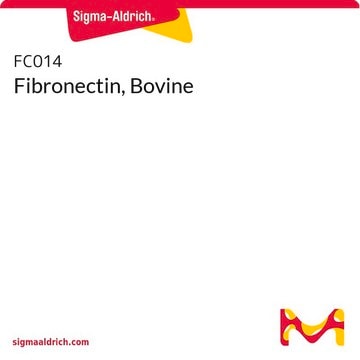F0635
Rat Fibronectin
from rat plasma, powder, suitable for cell culture
Synonym(s):
Fibronectin
About This Item
Recommended Products
product name
Fibronectin rat plasma, powder, BioReagent, suitable for cell culture
biological source
rat plasma
Quality Level
sterility
sterile
product line
BioReagent
form
powder
packaging
pkg of 0.5 mg
pkg of 1 mg
pkg of 2 mg
technique(s)
cell culture | mammalian: suitable
surface coverage
1‑5 μg/cm2
solubility
H2O: 1 mg/mL at 37 °C, clear, colorless (some particles)
UniProt accession no.
Binding Specificity
Peptide Source: Collagen
shipped in
dry ice
storage temp.
−20°C
Gene Information
rat ... Fn1(25661)
Looking for similar products? Visit Product Comparison Guide
General description
Application
Biochem/physiol Actions
Components
Caution
Preparation Note
In coating culture surfaces, fibronectin should be diluted in sterile balanced sterile salt solution and coated with minimal volume. Surface should then be air dried for 45 minutes at room temp and can be stored for 2-4 weeks at 2-8°C.
Analysis Note
Storage Class Code
11 - Combustible Solids
WGK
WGK 3
Flash Point(F)
Not applicable
Flash Point(C)
Not applicable
Personal Protective Equipment
Certificates of Analysis (COA)
Search for Certificates of Analysis (COA) by entering the products Lot/Batch Number. Lot and Batch Numbers can be found on a product’s label following the words ‘Lot’ or ‘Batch’.
Already Own This Product?
Find documentation for the products that you have recently purchased in the Document Library.
Customers Also Viewed
Articles
Fibronectin (FN) plays crucial roles in extracellular matrix fibril assembly and cellular interactions.
Fibronectin (FN) plays crucial roles in extracellular matrix fibril assembly and cellular interactions.
Fibronectin (FN) plays crucial roles in extracellular matrix fibril assembly and cellular interactions.
Fibronectin (FN) plays crucial roles in extracellular matrix fibril assembly and cellular interactions.
Protocols
Dilute fibronectin for cell attachment, varying per cell type. Coating protocol, products, and FAQs provided.
Dilute fibronectin for cell attachment, varying per cell type. Coating protocol, products, and FAQs provided.
Our team of scientists has experience in all areas of research including Life Science, Material Science, Chemical Synthesis, Chromatography, Analytical and many others.
Contact Technical Service






